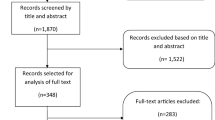Abstract
Scalp hair and fingernail samples of 42 medical radiographers and 42 nonradiographers (control) with matching age groups and food habits were collected for this study. Trace metal estimation by atomic absorption spectrometry (AAS) has indicated a significant increase (P < 0.001) in Zn, Cu, and Cd contents in the radiographers’ hair and nails. Scanning electron microscopy (SEM) reveled structural changes in the hair and nails of radiographers. Significant alterations in the Zn and Cd contents along with extensive structural damage in the hair and nails probably indicate that low-dose Χ-radiation imposes stress on these radiation workers.
Similar content being viewed by others
References
United Nations Scientific Committee on Effects of Atomic Radiation. Report to the General Assembly, with annexes, United Nations, New York, p. 647 (1988).
J. I. Fabrikant, Adaptation of cell renewal systems under continuous irradiation,Health Phys. 52, 561–570 (1987).
L. Sagan, On radiation paradigms and hormesis,Science 245, 574, 621 (1989).
S. Wolff, Are radiation-induced effects hormetic?,Science 245, 573, 621 (1989).
ICRP 1990, Recommendation of the International Commission on Radiological Protection,Ann. ICRP 60,(21) 1–3 (1991).
A. M. Kuzin, The problem of low-level radiation and hormesis in radiobiology,J. Radiobiol. 31, 16–21 (1991).
A. B. Lansdown, Physiological and toxicological changes in the skin resulting from the action and interaction of metal ions,Crit. Rev. Toxicol. 25, 397–462 (1995).
S. P. Moos and K. K. S. Pillay, Trace metal profiles in the hair of cancer patients,J. Radioanal. Chem. 77, 141–147 (1983).
U. Tomza, T. Janicki, and S. Kossman, Instrumental neutron activation analysis of trace elements in hair: A study of occupational exposure to a non-ferrous smelter,Radiochem. Radioanal. Lett. 58, 209 (1983).
J. Chatterjee, K. De, A. K. Das, and S. K. Basu, Alteration of spermatozoal structure and trace metal profile of testis and epididymis of rat under chronic low-level x-irradiation,Biol. Trace Element Res. 41(3), 305–319 (1994).
J. Chatterjee, K. De, S. K. Basu, and A. K. Das, Low level x-ray exposures on rat skin: Hyperkeratinization and concomitant changes in biometal concentrations,Biol. Trace Element Res. 46, 203–210 (1994).
J. Chatterjee, K. Chowdhury, K. De, A. K. Das, S. K. Basu, and S. Majumdar, A trace metal (zinc and iron) study on low-dose x-irradiation response in rat skin,Health Phys. 73(2), 362–368 (1997).
E. Antila, H. Mussalo-Ranhamaa, H. Kantola, F. Atroshi, and T. Westermarck,Sci. Total Environ. 186, 251–256 (1996).
K. Ohta, W. Aoki, and T. Mizuno, Direct determination of cadmium in biological material using ETAAS with metal tube atomizer and matrix modifier,Mikrochim. Acta 1, 81 (1990).
D. N. Sing, W. B. Greens, R. A. Schreiber, and G. R. Henniger, inScanning Electron Microscopy Part III, Proceedings of a Workshop on Scanning Electron Microscopy in Pathology, O. Johori, and I. Corvin, eds., Illinois Institute of Technology Research Institute, Chicago, p. 645 (1973).
J. E. Coggle, The effect of radiation at the tissue level, inBiological Effects of Radiation, Chapter 6, Taylor and Francis, London, p. 103 (1983).
R. P. R. Dawber, inSkin Problems in Elderly, L. Fry, ed., Churchill Livingstone, London, pp. 301–314 (1985).
G. M. Vicker, H. Bultmann, U. Glade, and T. Hafker, Ionizing radiation at low doses induces inflammatory reactions in human blood,Radiat. Res. 128, 251–257 (1991).
R. L. Willson, Iron, zinc, free radicals, and oxygen in tissue disorders and cancer control, inIron Metabolism, Ciba Foundation Symposium, North Holland Elsevier, Oxford,51, 331–349 (1977).
C. S. Potten, Melanocytes and radiation-induced changes in pigmentation, inRadiation and Skin, 1st ed. Taylor and Francis, London, pp. 190–191 (1985).
L. Kinova, I. Penev, and T. Rigrov,J. Radioanal. Nuclear Chem., Articles122, 307 (1988).
G. D. Martin, J. A. Stanby, and I. W. F. Davidson, inToxic Metals and Their Analysis, E. Berman, ed., Heyden, London, p. 67 (1980).
Author information
Authors and Affiliations
Rights and permissions
About this article
Cite this article
Majumdar, S., Chatterjee, J. & Chaudhuri, K. Ulltrastructural and trace metal studies on radiographers’ hair and nails. Biol Trace Elem Res 67, 127–138 (1999). https://doi.org/10.1007/BF02784068
Received:
Revised:
Accepted:
Issue Date:
DOI: https://doi.org/10.1007/BF02784068




